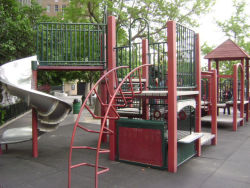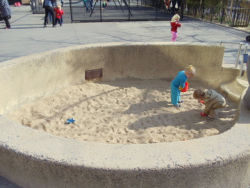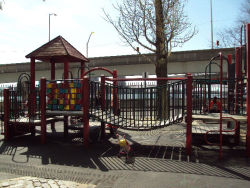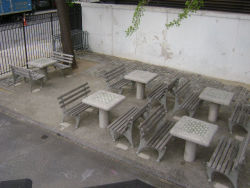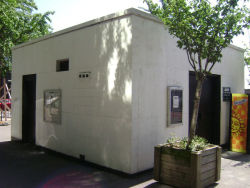MacArthur Playground
The Daily Plant : Thursday, January 26, 2006
PARKS, IN GENERAL

(National Archives and Records Administration)
Today marks the birth of General Douglas MacArthur (1880-1964), who served in World War II as the Supreme Allied Commander in the Pacific, and later as Commander in Chief of the United Nations forces during the Korean War.
If MacArthur’s standing as one of only five men in the history of the United States Army to reach the rank of Five Star General doesn’t impress you, then add to that the fact that he has two New York City parks named after him: one in Manhattan and one in Staten Island. (In comparison, his contemporary and five-star equal Dwight D. Eisenhower, who went on to serve as the President of Columbia University and then as President of the United States, has no parks named for him.)
The careful readers of this page might be wondering about George Washington, Ulysses S. Grant, and William T. Sherman. Due to their hasty promotion during the Civil War, Sherman and Grant came just short of being "official" five-star generals. Washington, along with John J. Pershing, actually reached a rank that exceeded the others and which Congress eliminated in 1870: General of the Armies of the United States.
All told, there are 26 parks and 16 monuments within New York City’s parks that are named after generals. More than half of the parks-honored generals fought in the Civil War. Counted individually, the leaders of the Revolutionary War come second after the Civil War; however, as far as tributes go, Washington and Lafayette alone account for half of the monuments and park namings for generals.
The Washington Square arch alone has two distinct sculptures of the leader. Lafayette, a French immigrant who aided the colonists through the provision of experienced military leadership, quickly became a favorite of Washington, who named him Major General in the Continental Army in 1777. Lafayette served valorously in the Virginia campaign.
Lafayette was not the only great general in American history who was not American. Another Revolutionary-era aid (who also holds the distinction of having the longest title of any park namesake) was Baron Friedrich Wilhelm Ludolf Gerhard Augustus von Steuben. After a distinguished career of service in Germany, he went to France in 1777 looking to secure employment in a foreign army. There he met Benjamin Franklin, who recruited him for the Continental Army. Although Steuben did not speak English, he proved instrumental in reorganizing Washington’s men, and led a division in the decisive battle of Yorktown, Virginia.
One of the most surprising and overlooked namings is Fort Tryon Park. Though the park is merely named for the fort that once stood there, the fort was originally in the series of strategic posts called Fort Washington. After the British took over the city, they named it for Sir William Tryon, a Major General and the last British governor of colonial New York.
In the nineteenth century, New York became the molten core of our nation’s melting pot. From this fantastic foundry of ours poured monuments to the great leaders of other counties, including Italian General Giuseppe Garibaldi and Argentine General José de San Martín. And, if you think naming parks for generals is generally a thing of past generations, go visit the Bronx triangle named for Major General John R. Brown, who rose to that rank during the Vietnam War, retired in 1972, died 20 years later, and received the honor of a park in 1995.
-written by John Mattera
QUOTATION FOR THE DAY
"Let everyone sweep in front of his own door and the whole world will be clean."
Johann Wolfgang von Goethe
(1749-1832)
Check out your park's Vital Signs
Clean & Safe
Green & Resilient
Empowered & Engaged Users
Share your feedback or learn more about how this park is part of a
Vital Park System

